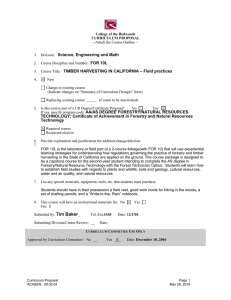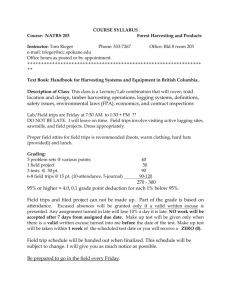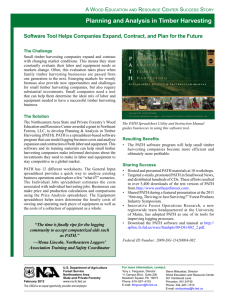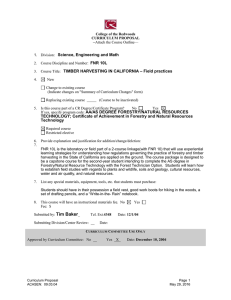Science, Engineering and Math FOR 10 TIMBER HARVESTING IN CALIFORNIA
advertisement
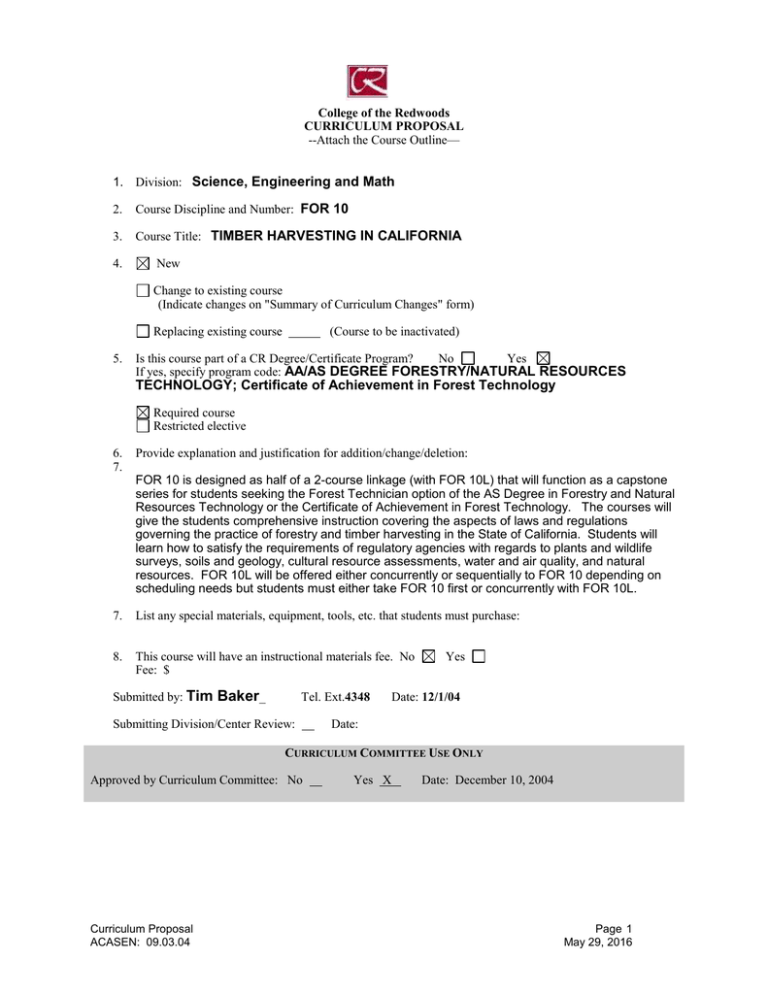
College of the Redwoods CURRICULUM PROPOSAL --Attach the Course Outline— 1. Division: Science, Engineering and Math 2. Course Discipline and Number: FOR 10 3. Course Title: TIMBER HARVESTING IN CALIFORNIA 4. New Change to existing course (Indicate changes on "Summary of Curriculum Changes" form) Replacing existing course 5. (Course to be inactivated) Is this course part of a CR Degree/Certificate Program? No Yes If yes, specify program code: AA/AS DEGREE FORESTRY/NATURAL RESOURCES TECHNOLOGY; Certificate of Achievement in Forest Technology Required course Restricted elective 6. 7. Provide explanation and justification for addition/change/deletion: FOR 10 is designed as half of a 2-course linkage (with FOR 10L) that will function as a capstone series for students seeking the Forest Technician option of the AS Degree in Forestry and Natural Resources Technology or the Certificate of Achievement in Forest Technology. The courses will give the students comprehensive instruction covering the aspects of laws and regulations governing the practice of forestry and timber harvesting in the State of California. Students will learn how to satisfy the requirements of regulatory agencies with regards to plants and wildlife surveys, soils and geology, cultural resource assessments, water and air quality, and natural resources. FOR 10L will be offered either concurrently or sequentially to FOR 10 depending on scheduling needs but students must either take FOR 10 first or concurrently with FOR 10L. 7. List any special materials, equipment, tools, etc. that students must purchase: 8. This course will have an instructional materials fee. No Fee: $ Submitted by: Tim Baker_ Tel. Ext.4348 Submitting Division/Center Review: Yes Date: 12/1/04 Date: CURRICULUM COMMITTEE USE ONLY Approved by Curriculum Committee: No Curriculum Proposal ACASEN: 09.03.04 Yes X Date: December 10, 2004 Page 1 May 29, 2016 SUMMARY OF CURRICULUM CHANGES FOR AN EXISTING COURSE FEATURES OLD NEW Catalog Description Grading Standard Units Lecture Hours Lab Hours Prerequisites Corequisites Recommended Preparation Maximum Class Size RepeatabilityMaximum Enrollments Other If any of the listed features have been modified in the new proposal, indicate the "old" (current) information and proposed changes. Course Outline Senate Approved: 09.03.04 2 May 29, 2016 College of the Redwoods Course Outline DATE: Dec. 1 2004 DISCIPLINE AND COURSE NUMBER: FOR 10 FORMER DISCIPLINE AND NUMBER (If previously offered): COURSE TITLE: Timber Harvesting in California [Lecture Units: 2.0 Lab Units: [Lecture Hours: 36 Lab Hours: ] TOTAL UNITS: TOTAL HOURS: ] MAXIMUM CLASS SIZE: 25 GRADING STANDARD: Letter Grade Only CR/NC Only Is this course repeatable for additional credit units: No Grade-CR/NC Option Yes how many total enrollments? Is this course to be offered as part of the Honors Program? No Yes If yes, explain how honors sections of the course are different from standard sections. CATALOG DESCRIPTION: The catalog description should clearly state the scope of the course, its level, and what kinds of student goals the course is designed to fulfill. A comprehensive lecture and discussion course covering the laws and regulations that govern the practice of forestry and timber harvesting in the State of California. Students will learn how to find and interpret the various agency policies and regulations as they apply to the preparation of documents to facilitate timber harvesting. Students will learn the history of the Z’berg-Nejedly Forest Practice Act and subsequent revisions and related federal and state laws. Legal terms and definitions as well as applications will be examined. Special notes or advisories: PREREQUISITES: No Yes Course: FOR 1, 5, 51, NR 52, 54, 58 Rationale for Prerequisite? Describe representative skills without which the student would be highly unlikely to succeed . Basic understanding of forest management, products and economics Identification of common species Land surveying skills Basic forest measurement skills Understanding of forest ecology Interpretation of aerial photos COREQUISITES: No Yes Course Outline Senate Approved: 09.03.04 Course: 3 May 29, 2016 Rationale for Corequisite? COURSE LEARNING OUTCOMES: What should the student be able to do as a result of taking this course? State some of the objectives in terms of specific, measurable student accomplishments. Make reasonable and practicable interpretations of relevant laws and regulations concerning the preparation of timber harvesting documents and the physical layout of timber harvests. Examine case studies and make appropriate decisions concerning the need for further environmental studies with regards for protecting soils, water, plants, and wildlife. Make assessments for potential impacts resulting from timber harvesting based on collected and recorded data. Develop sound reasoning for selected silvicultural prescriptions. Provide meaningful input in the development of Timber Harvest Plans. COURSE CONTENT Themes: What themes, if any, are threaded throughout the learning experiences in this course? The central theme of the course is the relevance of federal and California codes and regulations as they impact timber harvesting. Concepts: What concepts do students need to understand to demonstrate course outcomes? Understanding the various state and federal regulations in order to successfully develop THP planning and documentation. Understanding the current methodologies for acquiring the relevant field data and thus interpreting the data to complete the documentation. Issues: What primary issues or problems, if any, must students understand to achieve course outcomes (including such issues as gender, diversity, multi-culturalism, and class)? The dynamic working environment of the regulatory agencies and political entities involved with the timber harvest plan process. Responding to agency concerns. Awareness of native cultures in assessing needs for archaeological studies in THP planning. Skills: What skills must students master to demonstrate course outcomes? Locating and demonstrating applicability of relevant regulations for diverse resources Identification of environmentally sensitive areas requiring further study. Technical writing of relevant THP documents Working in groups to complete THP documents for case studies. REPRESENTATIVE LEARNING ACTIVITIES: What will the students be doing (i.e., Listening to lectures, participating in discussions and/or group activities, attending a field trip, etc.)? Relate the activities directly to the Course Learning Outcomes. Lecture dissemination of relevant histories and structures of regulations Discussion of applicability of various regulations in different case studies Identification of areas of concern with regards to timber harvesting Responding to various points of concern about proposed silvicultural prescriptions raised in case studies Developing a framework within a group for acquiring relevant data Producing THP documents in a group format Course Outline Senate Approved: 09.03.04 4 May 29, 2016 ASSESSMENT TASKS: How will the student show evidence of achieving the Course Learning Outcomes? Indicate which assessments (if any) are required for all sections. Representative assessment tasks: Comprehended rules and regulations. Development of timber harvesting documents. Critical responses to areas of concern Required assessments for all sections – to include but not limited to: Essay and definition exams. Project development and written reports EXAMPLES OF APPROPRIATE TEXTS OR OTHER READINGS Author Title Date Author Title Date Author Title Date Author Title Date (Author, Title, and Date Fields are required): Other Appropriate Readings: Forest Practices Act (published with yearly updates), other state and federal laws pertaining to forestry (various sources) Course Outline Senate Approved: 09.03.04 5 May 29, 2016 PROPOSED TRANSFERABILITY: UC CSU X If CSU transferability is proposed (courses numbered 1-99), indicate whether general elective credit or specific course equivalent credit is proposed. NONE X General elective credit Specific course equivalent If specific course equivalent credit is proposed, give course numbers/ titles of at least two comparable lower division courses from a UC, CSU, or equivalent institution. PROPOSED GENERAL EDUCATION: Rationale for General Education certification: BOTH 1. , (Campus) 2. , (Campus) NONE X CR UC CSU College of the Redwoods General Education Applicability: AREA Natural Science Social Science Humanities Language and Rationality Writing Oral Communications Analytical Thinking Rationale for inclusion in this General Education category: Proposed California State University General Education Breadth (CSU GE) Applicability A. Communications and Critical Thinking A1 – Oral Communication A2 – Written Communication A3 – Critical Thinking C. Arts, Literature, Philosophy, and Foreign Language C1 – Arts (Art, Dance, Music, Theater) C2 – Humanities (Literature, Philosophy, Foreign Language) B. Science and Math B1 – Physical Science B2 – Life Science B3 – Laboratory Activity B4 – Mathematics/Quantitative Reasoning D. Social, Political, and Economic Institutions D0 – Sociology and Criminology D1 – Anthropology and Archeology D2 – Economics D3 – Ethnic Studies D5 – Geography D6 – History D7 – Interdisciplinary Social or Behavioral Science D8 – Political Science, Government and Legal Institutions D9 – Psychology E. Lifelong Understanding and Self-Development E1 – Lifelong Understanding E2 – Self-Development Rationale for inclusion in this General Education category: Same as above Course Outline Senate Approved: 09.03.04 6 May 29, 2016 Proposed Intersegmental General Education Transfer Curriculum (IGETC) Applicability AREA 1A – English Composition 1B – Critical Thinking-English Composition 1C – Oral Communication (CSU requirement only 2A – Math 3A – Arts 3B – Humanities 4A – Anthropology and Archaeology 4B – Economics 4E – Geography 4F – History 4G – Interdisciplinary, Social & Behavioral Sciences 4H – Political Science, Government & Legal Institutions 4I – Psychology 4J – Sociology & Criminology 5A – Physical Science 5B – Biological Science 6A – Languages Other Than English Rationale for inclusion in this General Education category: Course Outline Senate Approved: 09.03.04 Same as above 7 May 29, 2016 FOR VPAA USE ONLY PROGRAM AND COURSE NUMBER FOR-10 TECHNICAL INFORMATION 1. Department: SCI Science 16. CoRequisite Course: 2. Subject: FOR 17. CoRequisite Noncourse: Course No: 10 3. Credit Type: D Credit Degree Applicable 18. Maximum Class Size: 25 4. Min/Maximum Units: 2.0 to 19. Repeat/Retake: NR No repeats variable units 5. Course Level: D Possibly Occupational 20. Count Retakes for Credit: yes no 6. Academic Level: UG Undergraduate 21. Only Pass/No Pass: yes no 7. Grade Scheme: UG Undergraduate 22. Allow Pass/No Pass: yes no 8. Short Title: Timber Harvesting in Calif 23. VATEA Funded Course: yes no 9. Long Title: Timber Harvesting in California 24. Accounting Method: W Weekly Census 03.0501 25. Disability Status: N Not a Special Class 10. National ID 11. Local ID (CIP): (TOPS): 011400 12. Course Types: Level One Basic Skills: NBS Not Basic Skills 26. Billing Method: T-Term 27. Billing Period: R-Reporting Term 28. Billing Credits: 2.0 Level Two Work Experience: NWE Not Coop Work Experience 29. Purpose: I Occupational Ed Level Three: 30. Articulation No. Placeholder for GE OR (CAN): Choose One: 31. Articulation Seq. Level Four: If GE : Choose One: 32. Transfer Status: B Transfers to CSU only 13. Instructional Method: LEC Lecture and/or Discussion 14. Lec TLUs: 3.0 Contact Hours: 36.0 Lab TLUs: Contact Hours: (CAN): 33. Equates to another course? 34. The addition of this course will inactive number). Inactive at end of term. 15. Prerequisite: FOR-1, 5, 51, NR-52, 54, and 58 Particular Comments for Printed Catalog. . Curriculum Approval Date: December 10, 2004 Course Outline Senate Approved: 09.03.04 (course number). 8 May 29, 2016 (course
